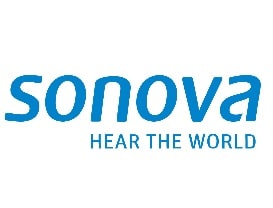STAEFA, SWITZERLAND — Major hearing instrument manufacturer Sonova, during its 2015 Investor and Analyst Day at its international headquarters in Switzerland, has confirmed that it will incorporate 2.4GHz wireless connectivity, with a new chip, in its next generation of hearing instruments. The new chip will use the standard protocol, rather than the current 2.4GHz system used in conjunction with Phonak’s Roger Pen. The company projects they will move to the new wireless platform by late 2016 or early 2017.

Starkey’s Halo uses 2.4GHz connectivity
The news that Sonova is adopting 2.4GHz is significant, with half of the Big Six hearing aid manufacturers{{1}}[[1]]The “Big Six”: Sonova, William Demant, Sivantos (Siemens), Widex and Starkey, account for approximately 98% of the global marketshare of hearing aids[[1]] now using the technology, with others rumored to be following suit.
Analysts had previously criticized Sonova, the largest hearing aid manufacturer in the world, for not using 2.4GHz wireless connectivity or some other type of dongle-free direct hearing aid audio streaming. Failure to incorporate such connectivity seemed to put Sonova at a competitive disadvantage, especially in light of GN ReSound’s substantial success using 2.4GHz connectivity in its instruments.
2.4GHz Becoming Industry Standard
While some hearing aid manufacturers have developed their own proprietary wireless systems, the 2.4GHz system was first adopted and widely promoted by GN ReSound.
The major advantage and appeal, for consumers and professionals, is due to the fact that using the 2.4GHz system no longer requires a need for an intermediary device (i.e., remote or dongle such as Phonak’s Roger) to relay the audio signal back to the hearing aids. Hearing aid users can now directly stream audio to their hearing aids and access their instrument settings through an iPhone or Android App.
Whether or not Sonova’s decision to adopt and implement 2.4GHz wireless connectivity into its upcoming products will have any significant impact on other manufacturers’ competitiveness remains to be seen.







It was my understanding that the majority of the industry had stuck for as long as it did with the near field magnetic induction communications system due to it’s superior ear to ear, through the head capabilities, as compared to the 2.4GHz systems, which have better range for communications with remote devices, buy had reportedly suffered from head shadow degradation in ear to ear communications.
How has that changed?
Do these new 2.4GHz systems only incorporate the 2.4GHz RF signal, or are they a hybrid with near field magnetic induction for ear to ear communications, and 2.4GHz RF reserved for direct device to Hearing Aid communications?
Or, have these new systems been able to overcome the head shadow degradation in order to communicate ear to ear in real time, as is needed for advanced, microphone array beam-forming?